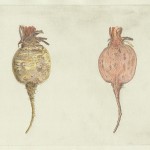“It is not an inspiring vegetable, unless you have a medieval passion for highly colored food. I have never heard anyone claim it as their favourite.”–Jane Grigson, The Vegetable Book
With beets, it’s an image problem. They are unkempt and whiskery and quick to bleed. This is no way for a vegetable to behave, even a root vegetable. But, like young boys, while some may be rotten, there are no bad beets.
It is fitting that the Vandals would take a shine to the barbarous beetroot, carrying it home with them once they were through overrunning Gaul and Spain and sacking Rome. In the early Middle Ages, some Germanic gardener got the fancy idea of squashing the elongated wild beetroot, arriving at the familiar turnip shape.
Now round, the beet rolled north through Poland to the Baltic states, then took a right into Russia and another right into eastern Europe, attaining a number of culinary expressions, not the least of which was animal feed, though perhaps best known is the glorious borscht.
On its home turf, you can’t throw a brick without it landing in a bowl of borscht. And, of course, one man’s borscht is another woman’s charlatan. Recipes bristle and swarm, local distinctions are defended to the last spoonful.
There are chilled versions, where the root goes into a Cinderella routine, the sweetness brimming beneath its rude exterior and all that brilliant color released into creamy elegance. There are hot versions, and more hot versions. Darra Goldstein, in A La Russe, mentions over a hundred varieties from the Ukraine alone. Beets are the common denominator (though there is also a green borscht flavored with sorrel and spinach)–that fabulous purple–but the folks from Kiev add lamb and garlic, while those over in Lvov prefer a small, mild frankfurter. Potato goes into the Galacian soup, the citizens of Chernigov toss in yellow squash, over in Poltava poultry and dumplings get the nod. Sugar is added to further sweeten some concoctions, or lemon for tartness, or soused apples for the pucker.
Beet eaters continued to tinker with the root. The Italians dandified the classic deep-purple beet (which have names like gang members: Crosby’s Egyptian, Detroit Dark Red) by turning it pink with white rings, a widely available heirloom known as Barbarietola di Chiogga, or just Chiogga for short. (Don’t expect the color to hold; it typically bleeds and evens.) There are cylindrical beets–the Formanova and the cunningly named Cylindra–that are handy for slicing, and there are gold and yellow and white beets, handy for not tattooing your fingers or anything else they touch, including other foods. Remarkably, they all taste like beets, though I find the red more earthy and the baby beets too sugary or bitter at the expenses of flavor.
Beets have profited from the boon in locally grown, organic, and antique varieties of produce over the past 20 years. Homely, perhaps, but no longer low rent. Currently, the jury seems to favor baking over boiling. Baking preserves the beet’s color and nutrients, heightens their sugariness, concentrates the flavor, and makes their flesh more savorous. Trim the stalks to 2 inches, leave the roots and skin on, and bake covered with foil (folded to catch the drips) or in a baking dish at 350 degrees until tender; this can be hours depending on size. Or you can steam the beets, with those the size of a pool ball taking about a half hour. Either way, the skins will slip off like pajamas. You may want to boil the big bubbas, such as the mangels and mangolds, two types of sugar beets that can weigh in at 10 pounds and would likely take a month to bake through.
The uses to which beets can be put, other than borscht, are legion: pickled, cooked or grated raw in salads, buttered, sugared, mixed with cream and herring, in a gratin. They are prized as raw juice. My personal beet favorite is red-flannel hash–onions and potatoes and beets fried in a little bacon fat–a treat not to be confused with calico hash, I’ve been warned, which is corned-beef hash made with beets, and also mighty tasty.
By all means don’t forget the greens; they’re what attracted humans to the plant in the first place, way back when on the storm battered Atlantic coast of North Africa. The yellow beets have a particularly succulent leaf, as do the Early Wonder red beets, good in soups and for stuffing pasta. Then there are the lithe, metallic-purple leaves of MacGregor’s Favorite, an heirloom Scottish beet grown for its tops. It’s as endearingly close as a beet will ever get to making a fashion statement.
(from The Vinegar Factory)
